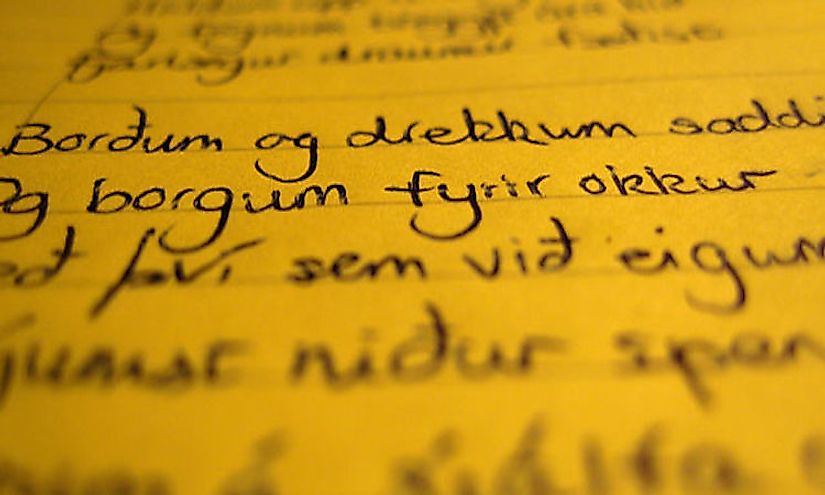What Languages Are Spoken In Iceland?

The Icelandic Language
Icelandic, the official language of Iceland, is an Indo-European language of the North Germanic languages. The language is closely related to Faroese and Norwegian with minor differences resulting from Celtic influence in the ancient Icelandic literature. Iceland as a country is isolated and exhibits linguistic homogeny. It has never had several languages. In the past, Gaelic was the native language of the early Icelanders. Icelandic is not only the national identity of Icelanders but also the official language of the country as adopted but their constitution in 2011. Besides, Icelandic sign language, as of 2011, is the official minority language.
Origin of Icelandic
The Icelandic language is part of the Germanic languages. This North German subgroup had five languages Norwegian, Faroese, the extinct language of Norn, Greenlandic Norse, and Icelandic. However, Icelandic is more similar to Faroese than Norwegian, and the Faroese written form resemble Icelandic.
History
Icelandic is quite an insular language such that other languages have not influenced it. The language had hardly changed from the 9th and 10th century when Iceland was settled. Norwegian was similar to Icelandic but from the 14th century, it became increasingly influenced by neighboring languages like Swedish and Danish. The Language resistance to change is so exclusive that today's speakers can understand texts and scripts like Sagas from the 12th century.
In the 18th century, the Danish influence almost threatened the integrity of the language. Under the Danish rule, Danish became a minority language in the country. However, Icelanders propelled past the threat by continuing to use Icelandic for literary purposes. Other factors that contributed to Icelanders' victory over Danish were; the Icelanders were scattered all over. As much as the Danish-ruled Iceland, the country geographical remoteness discouraged any long time settling of the Danish and the Danish language is linguistically different from Icelandic.
Even when the Scandinavian languages across Europe were losing inflection, Icelandic maintained Old Scandinavian grammar to an almost authentic form. The native Bible further developed Icelandic. However, the language was restricted until in the 19th century when Iceland came together as a nation and Scandinavian scholars rediscovered it. A strict orthography along etymological lines was set and today, Icelandic is very different from other Scandinavian languages.
Modern Icelandic
Regarding grammar, vocabulary, and orthography modern Icelandic has conserved the Scandinavian tongue in the best way possible. The language has retained its three genders: masculine, feminine, and neuter. The four cases for nouns; Accusative, dative, nominative, and genitive, still exist. Even though the language adopted some terms from Celtic, Latin, Danish, and Roma, the language purism of the 19th century has replaced foreign words with Icelandic forms. Icelanders opt to make new word rather than borrow from foreigners. For example "tolva," computer in Icelandic was conjured from two words "tala," meaning number and "Volva" a witch or fortune teller, so computer to Icelanders means a witch of figures "Islenska" coined in the 16th century describes Icelander's mother tongue.
Origin Of Foreign Languages Of Iceland
Icelandic has survived many centuries unchanged despite adopting some features from the Gaelic Language. The country retained a linguistic homogeny for a long time but with the advent of northern trade routes, the language environment was about to change. The traders, merchants, and clergymen introduced English, German, French, Dutch, and Basque in Iceland. Swedish and Danish are not actual foreign languages as since they are geographically positioned near Eastern Scandinavia.
Iceland has a population of about 332,529. Approximately 93.2% of that population speaks Icelandic. Despite language purism, Icelanders know the critical of international and foreign languages. As such English and any other Scandinavian language are compulsory in the Icelandic education system. Danish is standard due to its historical ties with Iceland and today 0.31% of the total population is Danish. English, the second choice is valued for its status as the international language. About 0.32% of the population speaks English. German is mostly the third language where 0.31% of the population converse in it. The local Polish community is the biggest minority in Iceland and as such 2.71% of people in Iceland speak Polish.
What Languages Are Spoken In Iceland?
| Rank | Language | % Of Population Speaking The Language |
|---|---|---|
| 1 | Icelandic | 93.2% |
| 2 | Polish | 2.71% |
| 3 | Lithuanian | 0.43% |
| 4 | English | 0.32% |
| 5 | German | 0.31% |
| 6 | Danish | 0.31% |
| 7 | Portuguese | 0.28% |
| 8 | Filipino | 0.24% |
| 9 | Thai | 0.17% |
| 10 | Latvian | 0.14% |
| 11 | Others | 1.89% |







